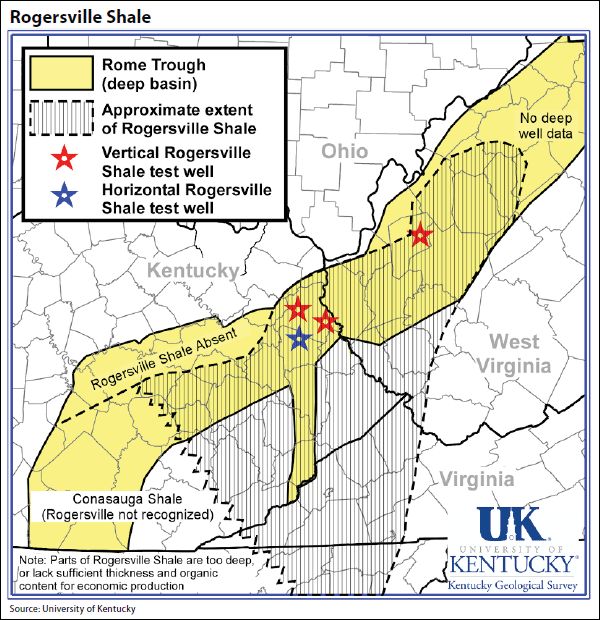Hints abound that Rogersville may be next big Appalachian shale
Hints abound that Rogersville may be next big Appalachian shale
Friday, April 10, 2015 11:40 AM ET
Hints abound that Rogersville may be next big Appalachian shale
By Bill Holland
The Rogersville Shale in northeast Kentucky and southwest West Virginia has every indication it could be the next big shale: landmen overcrowding courthouses, farmers signing leases, drillers sinking test wells, even a newly formed group opposing hydraulic fracturing.
Missing: any idea of how much gas is in the ground.
But the Rogersville was big enough for the Potential Gas Committee, or PGC, which uses both publicly available information and confidential company data supplied volunteers in the oil and gas industry, to put it on the map with the other big Appalachian shales, the Marcellus and the Utica.
The Colorado School of Mines-based PGC added 92 Tcf more of technically recoverable natural gas in the Atlantic region to its 2014 assessment of the gas resource base in the eastern U.S. That was a 12.8% increase to 833.4 Tcf and based, the PGC said, on new information from the several thousand Utica and Marcellus wells drilled in the past two years and a first-time assessment of the Rogersville, "an embryonic play."
"We don't have any production numbers," Dave Harris, the geologist who heads the Energy & Minerals Section of the Kentucky Geological Survey, or KGS, said on April 9. "All the wells are confidential, at this point. Resource numbers are nonexistent right now."
Interest in the Rogersville was spurred by a core sample from a 1975 Exxon Mobil Corp. brine disposal well drilled in Wayne County, West Virginia, that identified the source rock that is the Rogersville.
With a depth between 5,000 and 10,000 feet in eastern Kentucky, making it slightly more expensive to drill than the Marcellus or Utica, the Rogersville is thick — between 700 and 1,100 feet in Kentucky — with a total organic content between 2% and 4.8%, generating hydrocarbons that get dryer as the shale gets deeper and moves eastward into West Virginia, the KGS said.
Bruin Exploration, under contract to Cimarex Energy Co, drilled a vertical test well to an unknown depth in late 2013 but the results are confidential for five more years, KGS says.

Whatever the results were, Harris said, Cimarex "went on a massive leasing frenzy and other companies followed suit."
The shale slims down to between 100 and 200 feet further east in West Virginia, according to senior geologist Jessica Moore with the West Virginia Geological and Economic Survey. "The nexus of the play will probably be in Kentucky," she said.
"It's a small number of data points that have gotten people excited," Philip Dinterman, also a senior geologist with the West Virginia survey, said, because the organic content of the Rogersville, a predictor for the presence of oil and gas, is greater than the Utica.
"We have people who are looking for the next big thing," Dinterman explained the sudden excitement around the new shale.
Cabot Oil & Gas Corp. has taken out a permit to drill a 14,000-foot test well targeting the Rogersville in Putnam County, W.Va., deeper into what's thought to be the dry gas portion of the shale but along the same geographic line as the Cimarex No. 1 Young and Exxon Smith No. 1 wells, Harris said.
Among the companies chasing Cimarex and Cabot are Chesapeake Energy Corp., Continental Resources Inc., and EQT Corp., Harris said, although leasing efforts seemed to have slowed with the drop in both oil and natural gas prices.
Cimarex and Cabot did not return calls or emails regarding their Rogersville plans.
How amenable to the multipad drilling and completion techniques of the gas industry's "factory" approach to shale extraction remains to be seen. According to a November 2014 KGS presentation, the "source rock quality in Rogersville is variable — not a uniform rich source. Controls on total organic content distribution [are] not well understood."
"Shallower, less mature areas of Rome Trough [are] likely more liquids-prone than deeper areas in West Virginia," the KGS posited. The Rome Trough is the larger geological basin containing the Rogersville Shale.
A "viable petroleum system exists in the Rome Trough," KGS said in its presentation. "Rogersville Shale is [the] primary source interval."
Paving the way for shale extraction, the Kentucky legislature updated the state's oil and gas laws in March to regulate hydraulic fracturing, adding requirements for pre- and post-drilling water testing and disclosure of the chemical contents of frack fluids with a trade secret exemption.
Only two legislators voted against the bill, which the governor signed into law March 19.
Despite the overwhelming number of Kentucky lawmakers voting in favor of high volume hydraulic fracturing, an opposition group, Frack Free Foothills organized itself late in 2014, calling for a moratorium in fracking. The older, more established Kentucky Waterways Alliance, based in Louisville, Ky., wants the water testing regulations strengthened and penalties for polluting ground water to be added.
Copyright © 2015, SNL Financial LC
Usage of this product is governed by the License Agreement.
SNL Financial LC, One SNL Plaza, PO Box 2124, Charlottesville, Virginia 22902 USA, (434) 977-1600

Tags:
Replies to This Discussion
Top Content
Latest Activity
- Top News
- ·
- Everything
© 2025 Created by Keith Mauck (Site Publisher).
Powered by
![]()
| h2 | h2 | h2 |
|---|---|---|
AboutWhat makes this site so great? Well, I think it's the fact that, quite frankly, we all have a lot at stake in this thing they call shale. But beyond that, this site is made up of individuals who have worked hard for that little yard we call home. Or, that farm on which blood, sweat and tears have fallen. [ Read More ] |
Links |
Copyright © 2017 GoMarcellusShale.com
